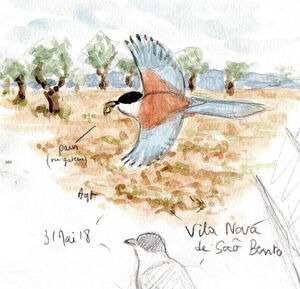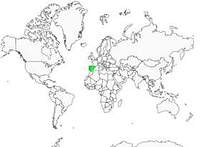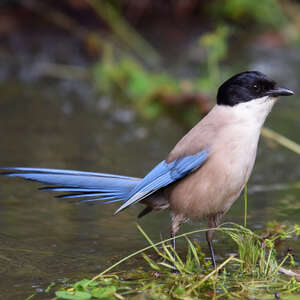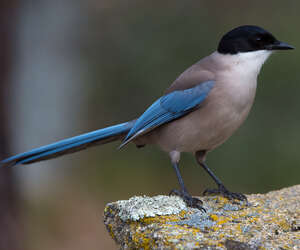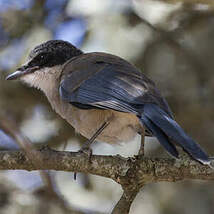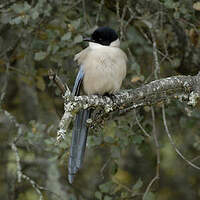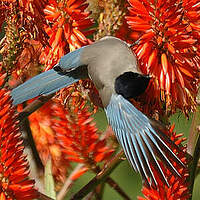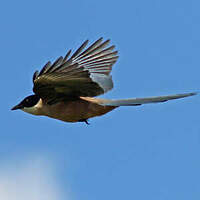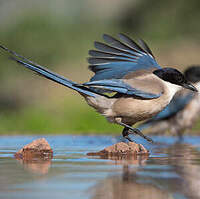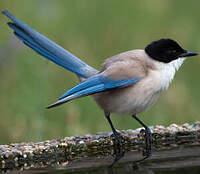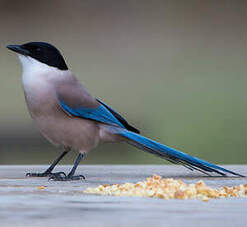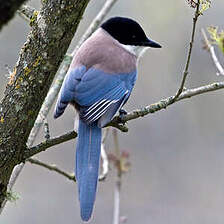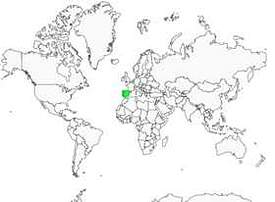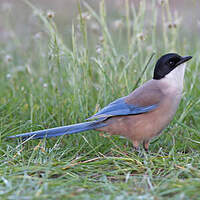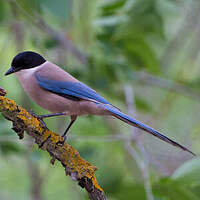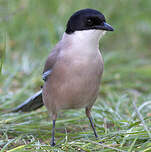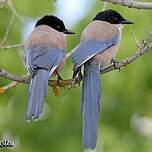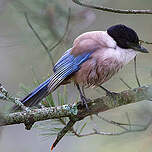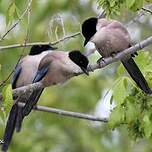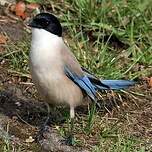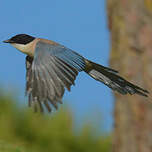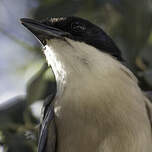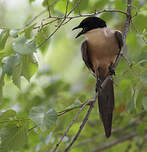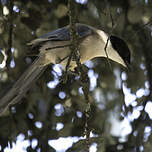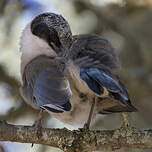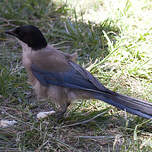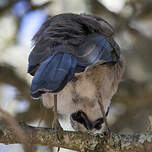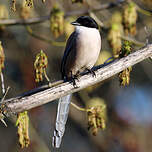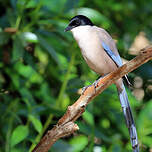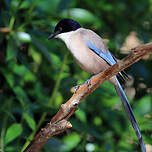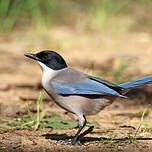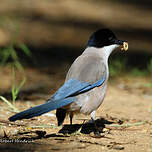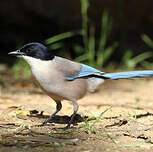Iberian Magpie
Cyanopica cooki - Pie ibérique Pie-bleue ibérique
Identification
Present throughout the Iberian Peninsula, no one can miss it. The Iberian Magpie is of a respectable size (35 cm) and has beautiful colors that make it instantly recognizable. The head is black, the entire crown and forehead are like painted, the separation between the black head, the white throat and the light brown nape is very clear. The beak is strong, also black; at the base of the beak there are small moustaches also black, the eye is black. The mantle and back are light brown like the large and medium greater-wing coverts, the remiges are a beautiful light blue, the outer edge of the remiges with a light white stripe; the Subcaudaliy feathers are gray-blue. The long tail (up to 20 cm!) which can be half, or even a little more, the size of the bird is also light blue. The throat is white and fades to sandy color slightly pinkish on the abdomen and lower belly, a little clearer than the brown back. In flight the under-wing coverts are very light blue and the coverings appear light brown, almost cream. The young will have a darker brown cap first. The adult brown colors on the mantle and coverings are much lighter, the remiges show light streaks on a light blue background. There is no differentiation between male and female. The Iberian Magpie seems perched directly on its black tarsi, the tibiae are rarely distinguished.
Subspecific information monotypic species
Foreign names
- Pie ibérique,
- Rabilargo ibérico,
- charneco,
- Blauelster,
- Blauwe Ekster,
- Gazza aliazzurre iberica,
- iberisk blåskata,
- Blåskjære,
- modraňa strakovitá,
- straka iberská,
- Ibererblåskade,
- garsa blava ibèrica,
- sójka iberyjska,
- Иберийская сорока,
- イベリアオナガ,
- 蓝尾灰喜鹊,
- iberisk blåskata,
- 中東灰喜鵲,
Voice song and call
Habitat
The Iberian Magpie loves open forests and seeks out oak groves, lush meadows and orchards, and olive plantations. It enjoys recent eucalyptus plantations. It can be found at up to 700 m in altitude, and even higher in the centre and south-west of Spain, often in dunes and pine forests, where it appears to be comfortable, as this environment seems to favour its presence when compared to its cousin but nevertheless competitor, the Common Magpie (Pica pica).
Behaviour character trait
Dietfeeding habits
Our Iberian Magpie is completely omnivorous and loves insects, such as Coleoptera, insect larvae, diplopods, and snails, as well as varying its diet with different fruits, seeds and various berries.
Living in the land of the olive trees, it won't miss out on the fruits! Living in groups they explore everything in a tree, from fruits to larvae and insects, with some remaining in the tree and others exploring the ground. In preparation for difficult times, it will make stores often near rivers or streams, where the soil is soft.Reproduction nesting
The breeding period of the Iberian Magpie is from April to the end of May, or even the end of June in some individuals observed in the centre of Spain (1,250m).
monogamous, the couples remain together, even when they join large flocks, selecting a single tree to colonize. The nest is generally built by the female, with the male bringing sticks and helping her, later consolidating the nest with mud or manure and padding the inside with animal fibers, often wool from local flocks. It takes the pair between 10 to 18 days to build the nest, which is usually 3 to 7 meters high. The clutch usually contains 4 to 9 eggs and the female is the only one incubating for about 2 weeks, being fed daily by the male. The parents feed the chicks through regurgitation for 15-17 days, then the young leave the nest and perch calling the parents for food. Iberian Magpies have a family spirit and the teenagers help the parents feeding the chicks. Throughout the whole period until the moment of the fledge, the parents and the colony fiercely protect the nests from all kinds of aerial or terrestrial predators. Despite that, the nests sometimes suffer parasitism by the Common Cuckoo (Cuculus canorus) and the Great Spotted Cuckoo (Clamator glandarius).Geographic range
Mainly in Spain and Portugal, some observations have been made in the south-west of France but do not seem to be confirmed. The Iberian Magpie has always raised the beautiful stories of ornithology with the Blue-crowned Magpie, which is Asian. Some people may have thought that Portuguese navigators had brought Asian Blue Magpies on ships in their country in the 16th and 17th centuries and thus implanted the species in Spain and Portugal. Following research carried out in 2000, fossils were found in Gibraltar and proved that the Iberian Magpie already existed in Spain 40,000 years ago. DNA analysis recently carried out shows that they are two different species, probably separated during the last glaciation.
Threats - protection
IUCN conservation status
concern
in the Wild
threatened
evaluated
The Iberian Magpie doesn't appear to be in danger, but the situation can very quickly change. The destruction of many oak forests in Spain reduces its habitat where the population doesn't seem to be increasing. Competition with the jackdaw (Pica pica) can also turn against it, and where one of the two species takes the lead, the other decreases. However, increases have been noted in Portugal and at the border between the two countries, with eucalyptus plantations perhaps being a reason for the good health of the Iberian Magpie in these areas.
Sources of information
- IOC World Bird List (v15.1), Gill, F and D Donsker (Eds). 2025-12-07.
- Handbook of the birds of the world Vol.14, josep del Hoyo
- Le guide ornitho : Le guide le plus complet des oiseaux d'Europe, d'Afrique du Nord et du Moyen-Orient : 900 espèces, Svensson, Mullarney, Zetterstrom
- Guide des oiseaux de France et d'Europe, Roger Tory Peterson, Guy Mountfort, P. A. D (Phill
- ARKive, Christopher Parsons
- BirdLife International, BirdLife International
- Avibase, Lepage Denis
- THE AVIANWEB, Sibylle Faye
- Wikipédia, Wikipedia, The Free Encyclopedia
Other sources of interest
 Specification sheet created on
29/07/2023 by Anne et Gabriel Leboff
Specification sheet created on
29/07/2023 by Anne et Gabriel LeboffTranslation by AI Oiseaux.net
© 1996-2025 Oiseaux.net
- Accipitriformes
- Aegotheliformes
- Anseriformes
- Apodiformes
- Apterygiformes
- Bucerotiformes
- Caprimulgiformes
- Cariamiformes
- Casuariiformes
- Charadriiformes
- Ciconiiformes
- Coliiformes
- Columbiformes
- Coraciiformes
- Cuculiformes
- Eurypygiformes
- Falconiformes
- Galliformes
- Gaviiformes
- Gruiformes
- Leptosomiformes
- Mesitornithiformes
- Musophagiformes
- Nyctibiiformes
- Opisthocomiformes
- Otidiformes
- Passeriformes
- Pelecaniformes
- Phaethontiformes
- Phoenicopteriformes
- Piciformes
- Podargiformes
- Podicipediformes
- Procellariiformes
- Psittaciformes
- Pterocliformes
- Rheiformes
- Sphenisciformes
- Steatornithiformes
- Strigiformes
- Struthioniformes
- Suliformes
- Tinamiformes
- Trogoniformes

